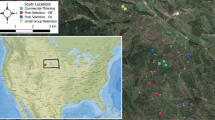Abstract
For 345 stands of deciduous hardwood forest in Hyogo Prefecture, Western Japan, we assessed the decline of shrub-layer vegetation due to sika deer in each stand by using the shrub-layer decline rank (SDR), determined by combining the shrub-layer vegetation cover and the presence of signs of grazing by sika deer in a stand. Since there was a geographical correlation between SDR and sighting per unit effort (SPUE), which is an index of the relative density of sika deer, it appeared that decline of shrub-layer vegetation in a stand can be accurately evaluated by SDR. There were correlations between SDR and several variables that indicate the status of components in forests (presence of saplings of tall trees, occurrence of bark stripping of tall trees, proportion of bark-stripped stems of Clethra barvinervis, decline of subtree-layer vegetation by bark stripping, cover of litter on the ground, and area of soil surface erosion). These results indicate that the status of these components changes with decline of shrub-layer vegetation by sika deer grazing. It is thought that such synchronizations are caused by sika deer grazing or a direct or indirect effect by decline of shrub-layer vegetation due to sika deer. Therefore, it is reasonable to assess decline in physical structure due to sika deer for stands of deciduous hardwood forests according to SDR.


Similar content being viewed by others
References
Akashi N, Nakashizuka T (1999) Effects of bark-stripping by sika deer (Cervus nippon) on population dynamics of a mixed forest in Japan. For Ecol Manage 113:75–82
Fujiki D, Suzuki M, Goto F, Yokoyama M, Sakata H (2006) Tree community structure in secondary forests affected by sika deer (Cervus nippon) herbivory. Jpn J Conserv Ecol 11:21–34 (in Japanese with English abstract)
Fujiki D, Samejima H, Sakata H (2007) Current status of wildlife and agricultural damage in Hyogo Prefecture. Monograph of natural history and environmental science, no. 3. Museum of Nature and Human Activities, Hyogo (in Japanese)
Furusawa H, Miyanishi H, Kaneko S, Hino T (2003) Movement of soil and litter on the floor of a temperate mixed forest with a impoverished understory grazed deer (Cervus nippon centralis Temmink). J Jpn For Soc 85:318–325 (in Japanese with English summary)
Hino T, Furusawa H, Ito H, Ueda A, Takahata Y, Ito MT (2003) Forest ecosystem management based on an interaction network in Ohdaigahara. Jpn J Conserv Ecol 8:145–158 (in Japanese with English abstract)
Miyawaki A (1984) Vegetation of Japan, vol. 5. Shibundo, Tokyo (in Japanese)
Nomiya H, Suzuki W, Kanazashi T, Shibata M, Tanaka H, Nakashizuka T (2003) The response of forest floor vegetation and tree regeneration to deer exclusion and disturbance in a riparian deciduous forest, central Japan. Plant Ecol 164:263–276
Sakata H, Hmasaki S, Kishimoto M, Mitsuhashi H, Mitsuhashi A, Yokoyama M, Mitani M (2001) The relationship between sika deer density, hunting pressure and damage to agriculture in Hyogo Prefecture. Hum Nat 12:63–72 (in Japanese with English abstract)
Shimoda K, Kimura K, Kanzaki M, Yoda K (1994) The regeneration of pioneer tree species under browsing pressure of Sika deer in an evergreen oak forest. Ecol Res 9:85–92
Takatsuki S, Gorai T (1994) Effect of Sika deer on the regeneration of a Fagus crenata forest on Kinkazan Island, northern Japan. Ecol Res 9:115–120
Tokida K, Torii T, Miyaki M, Okada H, Kohira M, Ishikawa Y, Satoh K, Kaji K (2004) A deer management approach to promote ecosystem management in National Parks: a case study of sika deer in Shiretoko, Hokkaido Island, Japan. Jpn J Conserv Ecol 9:193–202 (in Japanese with English Summary)
Wildlife Management Office (1994) Report of Heisei 5 year on analysis for the population dynamics of sika deer. Hyogo Prefecture, Hyogo (in Japanese)
Wildlife Management Office (2000) Report of Heisei 11 year on analysis for the population dynamics of sika deer. Hyogo Prefecture, Hyogo (in Japanese)
Acknowledgments
The authors would like to acknowledge financial support from the Museum of Nature and Human Activities, Hyogo, and also thank H. Samejima, M. Takahata, and Y. Kinoshita for their support in the field survey.
Author information
Authors and Affiliations
Corresponding author
About this article
Cite this article
Fujiki, D., Kishimoto, Y. & Sakata, H. Assessing decline in physical structure of deciduous hardwood forest stands under sika deer grazing using shrub-layer vegetation cover. J For Res 15, 140–144 (2010). https://doi.org/10.1007/s10310-009-0172-2
Received:
Accepted:
Published:
Issue Date:
DOI: https://doi.org/10.1007/s10310-009-0172-2




